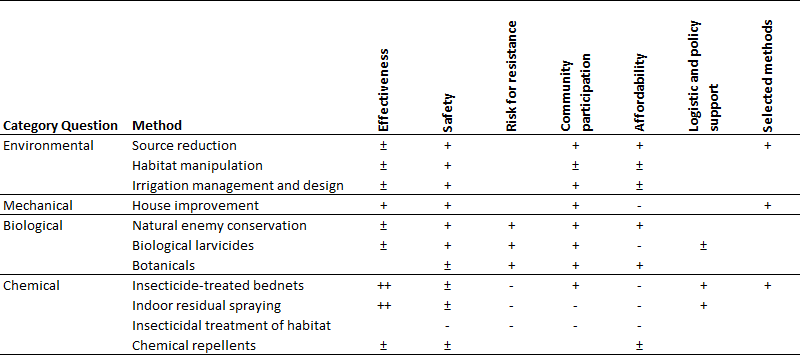
Available methods
Vector control strategies are categorised into four groups: biological, chemical, environmental, and mechanical. Methods within these categories are outlined in Table 1, along with their applicability to selected diseases. It should be noted that the implementation of a vector control method may impact several diseases where they co-exist, so a programme of source reduction for example could help to prevent cases of dengue and lymphatic filariasis. Equally, complementary effects may be seen when more than one method is used, so they should be combined whenever possible.
Table 1. Methods used to control Vector-Borne diseases

Selection criteria
It is unlikely that a single control agent will be suitable for all types of mosquito breeding sites, or is adapted to all environmental conditions, and the concomitant adoption of different means may produce the best outcomes. Before deciding which vector control methods to implement, an appraisal should be made of the advantages and disadvantages of each method. This should include an assessment of effectiveness, potential risk of development of resistance, human and environmental safety, affordability, community participation, policies, and logistic support. Appraisal and selection of a control method involves technical, managerial and social factors, and must be made with all relevant stakeholders. Further, the methods should be assessed locally to make sure they are appropriate for local implementation.
Effectiveness
The effectiveness of intervention measures can depend on the species, their ability to transmit diseases, breeding habitat, behaviour and susceptibility to insecticides. Meta-analyses have shown for example that house screening significantly reduces dengue risk but bed net have not been found to have an effect[1], while treated bed nets and indoor residual spraying are both effective in controlling malaria [2,3]. The effectiveness of different interventions should be assessed, where possible, using evidence from studies with local vectors. Obtaining evidence on the effectiveness of interventions in terms of reducing the incidence of disease, rather than just impacting vector populations or disease transmission, is crucial.
Development of resistance
The use of insecticides for public health and agricultural purposes has led to the widespread occurrence of insecticide resistance. This limits the utility of interventions that are already in place and narrows the opportunity for chemical control in the future. The potential for insecticide resistance to develop should therefore be considered.
Human and environmental safety
The use of chemicals to control vectors can pose a risk to the health of some individuals and the environment. Fogging for example is primarily used in outbreak situations, as repeated use might have negative impacts on non-target species.
Community participation
It is crucial to have community participation in control efforts to ensure their effectiveness and sustainability[4]. Some methods, such as house improvement and environmental management, require active participation from community members, while others merely require the community to accept the intervention. The ability to get community engagement should be assessed.
Affordability
The national or district budget set aside for vector control may limit the options available to some communities. Further, the willingness of community members to invest time and resources in the programme have to be considered when interventions are considered.
Policies and logistic support
Any intervention that is selected will rely on policy support and logistical help to implement, so the availability of resources and willingness of authorities to contribute to a control method will impact on its success.
When these factors have been considered, the most suitable method or methods of control can be selected, as exemplified in Table 2.
Table 2. Example of the criteria used to select malaria vector control methods. (++, highly applicable; +, applicable, ±, partly applicable; –, not applicable, “Selected methods”, methods chosen for implementation)

Multiple diseases
When there are multiple diseases threatening an area, decisions need to be made not just on the methods to target the vector species but the relative importance of each disease, particularly if resources are limited. Opportunities for synergistic effects should be sought, as many vector control interventions can impact the prevalence of more than one disease, and it may be possible to reduce rates of a low-priority disease that otherwise wouldn’t have justified the effort. This could be achieved through the optimal combination of methods that cover an entire complex of vector species.
References
- Bowman LR, Donegan S, McCall PJ. Is dengue vector control deficient in effectiveness or evidence?: Systematic review and meta-analysis. PLoS neglected tropical diseases. 2016 Mar 17;10(3):e0004551.
https://journals.plos.org/plosntds/article?id=10.1371/journal.pntd.0004551 - Kim D, Fedak K, Kramer R. Reduction of malaria prevalence by indoor residual spraying: a meta-regression analysis. The American journal of tropical medicine and hygiene. 2012 Jul 2;87(1):117-24.
https://www.ncbi.nlm.nih.gov/pmc/articles/PMC3391035/ - Strode C, Donegan S, Garner P, Enayati AA, Hemingway J. The impact of pyrethroid resistance on the efficacy of insecticide-treated bed nets against African anopheline mosquitoes: systematic review and meta-analysis. PLoS medicine. 2014 Mar 18;11(3)
https://journals.plos.org/plosmedicine/article?id=10.1371/journal.pmed.1001619 - Ballenger‐Browning KK, Elder JP. Multi‐modal Aedes aegypti mosquito reduction interventions and dengue fever prevention. Tropical Medicine & International Health. 2009 Dec;14(12):1542-51.
https://onlinelibrary.wiley.com/doi/pdf/10.1111/j.1365-3156.2009.02396.x